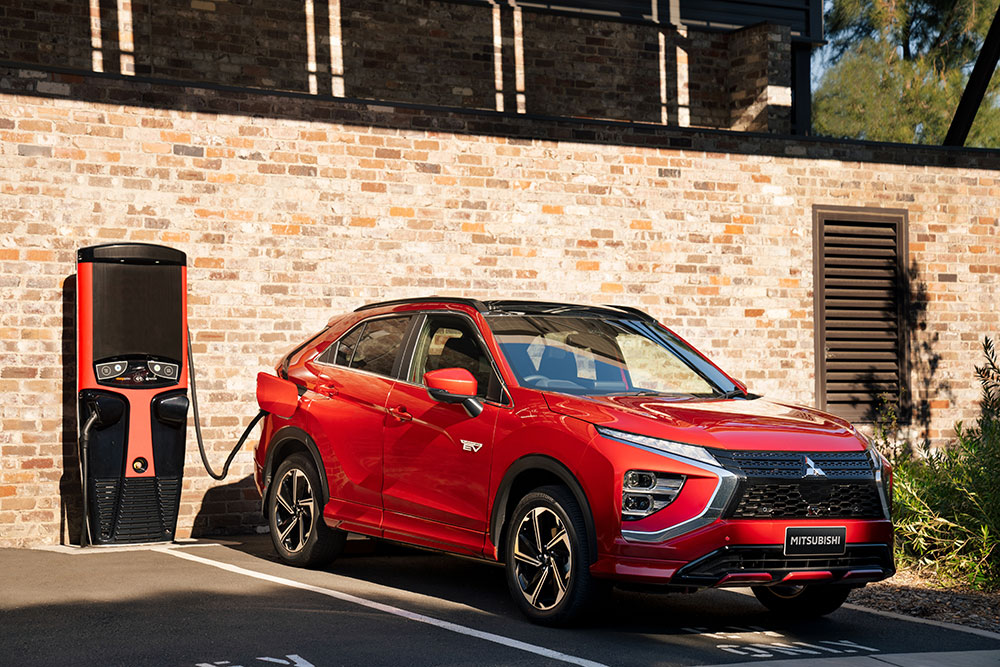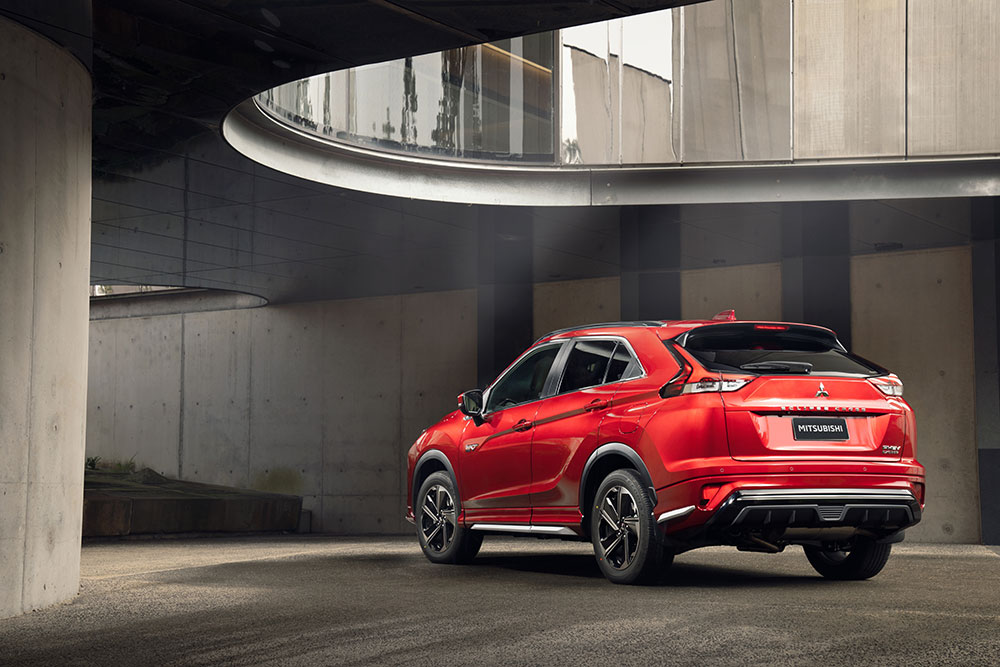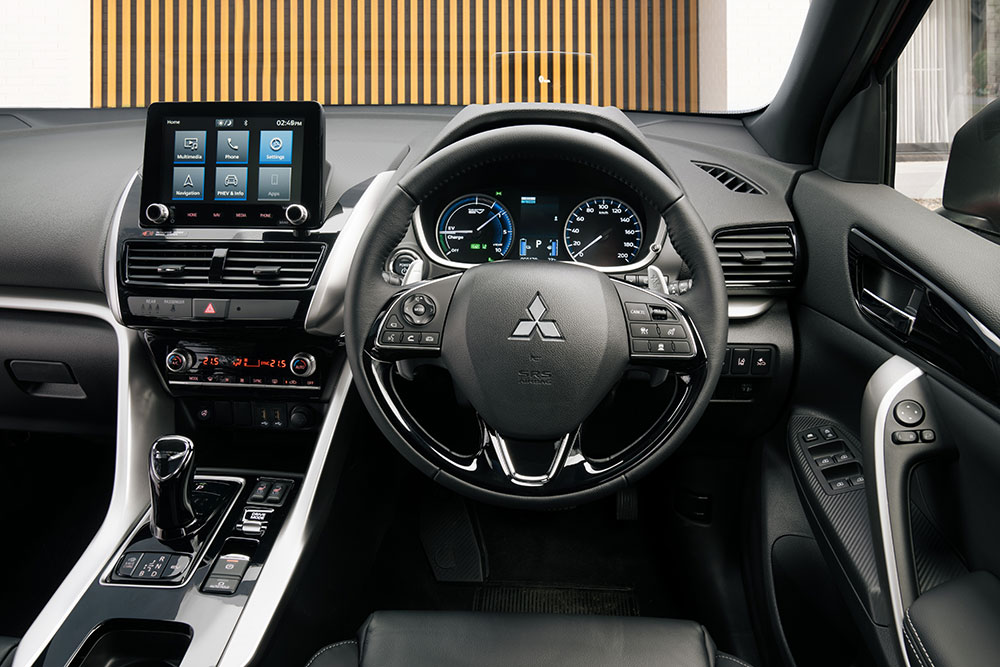Mitsubishi Eclipse Cross Exceed AWD PHEV review
This plug-in hybrid electric SUV from Mitsubishi couples zero-tailpipe emissions urban driving, with anxiety-free open road range.

Following closely in the wake of a recent update to the petrol-engine Eclipse Cross models, Mitsubishi has added three new PHEV (plug-in hybrid electric vehicle) variants to the family.
The release aligns with the company’s commitment to the broader adoption of low-emissions and electrified vehicles, including its promise of an EV, PHEV, or hybrid-electric variant in each segment it competes in by 2030.
With a claimed 55km or more of available electric range from its 13.8kWh lithium-ion battery, Mitsubishi believes the Eclipse Cross PHEV can be a hit with urban couples and families who are looking to lower their weekly running costs and reduce their environmental footprint.
Such range will allow the average driver to use pure EV mode for most of their weekly driving, assuming a top-up charge every night, the company says.
Model choice is simpler for Eclipse Cross PHEV buyers, with only half the number of grades as is offered on the petrol models, and all of them AWD.
However, going electric adds about $12,500 to the price of a similar spec AWD petrol-only model.
PHEV prices start at $46,490 for the ES, with the mid-spec listing at $49,990 and the Exceed at $53,990.
The PHEV benefits from updates to petrol models made in 2021, including a 140mm longer body with enlarged luggage capacity, extra safety and convenience features and a revised tailgate design for improved rear vision.
The PHEV also adds intelligent driving features via three drive modes that Mitsubishi claims reduce emissions and noise, and enhance driving comfort.
The powertrain is the latest iteration of that used in the larger Outlander PHEV, combining a 94kW, 2.4-litre four-cylinder Atkinson cycle petrol engine with two electric motors – a 60kW unit up front and a 70kW at rear.
The PHEV’s control system automatically and seamlessly selects the most efficient drive mode for the conditions, with regenerative braking available in all modes to improve efficiency.
EV driving can be selected manually, as can ‘battery charge’ and ‘battery save’ modes, and the level of regen braking can be adjusted via steering wheel paddle shifters.

The powertrain defaults to EV mode for ‘electric only’ propulsion around town before the system switches to series or parallel hybrid modes at higher speeds and on longer drives.
The PHEV’s electric drive offers strong torque, smooth acceleration and is comparatively quiet.
Series mode is available at speeds up to 70km/h and is automatically activated when maximum acceleration is required, under other high load conditions such as climbing hills, or when the battery charge gets low.
The car continues to drive on the electric motors with power from the battery and petrol engine generating power to charge the battery.
The vehicle reverts to EV mode as soon as possible after these high load conditions are completed.
Parallel hybrid mode sees the petrol engine driving the front wheels through a transaxle, with both electric motors lending their support to motive effort.
Any excess electrical energy produced is used to charge the drive battery.
This mode is available only above 70km/h with the system defaulting back to more-efficient EV or series hybrid modes whenever possible.
Working away in conjunction with all this sophisticated powertrain switching is Mitsubishi’s Super All Wheel Control (S-AWC) system, designed to optimise traction, torque distribution and stability in all driving conditions, with selectable drive modes for tarmac, gravel, normal and snow.
On the road, a blend of supple ride, accurate steering and competent and secure chassis dynamics, delivers an easy driving experience that will satisfy most buyers.
Officially a small SUV, the Eclipse Cross PHEV offers better than class-average interior space with comfortable seating and a usefully proportioned 359 litres (VDA) of cargo space.
That’s 46 litres less than the petrol models, thanks to engineering changes to accommodate the various electrical systems.

It also necessitates fitment of a ‘mobility kit’, designed to temporarily inflate and seal a flat tyre, in lieu of a full-size or space-saver spare.
Standard safety and driver assistance features on Exceed include lane departure warning, blind-spot warning, rear cross-traffic alert, forward collision mitigation with pedestrian detection, lane change assist, ultrasonic mis-acceleration mitigation, auto high beam, multi-view camera system, adaptive cruise control, adjustable speed limiter, head-up display, front and rear park sensors and seven airbags, including a driver’s knee airbag.
Exceed’s infotainment and connectivity requirements are taken care of with an 8-inch touchscreen, satnav, premium audio with eight speakers, DAB+ radio, Apple CarPlay and Android Auto, and two USBs (front only).
Some surprise equipment omissions from the top-spec Exceed’s inventory include rear USB ports, air vents for rear passengers, and an inductive phone charging pad.
However, the car does boast heated front and outer rear seats and a heated steering wheel for a little extra comfort in chilly weather.
A zero to 100% charge from a normal 10-amp AC home power outlet takes around seven hours, or around about half that time using a dedicated 32-amp AC EV charger.
Charging from zero to 80% capacity on a higher-voltage DC charger takes 25 minutes.
A battery cooling system in the vehicle is activated during plug-in charging to help maintain the battery in optimum condition, while a Smartphone Remote Control app allows drivers to remotely control functions like scheduling battery charging to take advantage of off-peak power tariffs.
The Eclipse Cross PHEV is also designed to be able to take advantage of bi-directional charging when this becomes locally available.
This means it’s enabled with Vehicle to Grid (V2G) and Vehicle to Home (V2H) capabilities, allowing the drive battery to be used for short-term mobile energy storage/power supply.
The new Eclipse Cross PHEV offers practical and appealing lower emissions mobility to those buyers not quite ready to take the plunge on a full-battery electric.
As such, it should play a key role in Mitsubishi’s strategy of having 50% of its global sales as electrified models by 2030.
Key stats
- MLP: $53,990
- ENGINE: Plug-in hybrid - 2.4-litre petrol 4-cyl/two electric motors
- ANCAP CRASH RATING: 5 stars (2017)
- FUEL CONSUMPTION (combined cycle, litres/100km): 1.9 (43g/km CO₂)
- FOR: Space, electric-only range enough for average commuting needs, a practical part electrified/low emissions option for many buyers, bi-directional charge capability.
- AGAINST: Inflator kit – no spare, some equipment omissions.
Related topics
Things to note
The information in this article has been prepared for general information purposes only and is not intended as legal advice or specific advice to any particular person. Any advice contained in the document is general advice, not intended as legal advice or professional advice and does not take into account any person’s particular circumstances. Before acting on anything based on this advice you should consider its appropriateness to you, having regard to your objectives and needs.
Insurance Products (excluding Travel Insurance) are issued by RACQ Insurance Limited ABN 50 009 704 152 (RACQI) and arranged by its agent, RACQ Distribution Services Pty Ltd (RDS) ABN 35 116 361 650, AFSL 567130 and RDS' authorised representatives (including RACQ Operations Pty Ltd ABN 80 009 663 414, AR No. 234978 (RACQO). Conditions, limits and exclusions apply. RDS and RACQO are in the RACQ group of companies. One of the companies in the RACQ group of companies has a minority shareholding in RACQI.
RDS and RACQO have not taken your personal objectives, circumstances or needs into account when preparing advice regarding insurance products and you will need to consider whether the advice is appropriate for you. Read the Product Disclosure Statement (PDS) and any applicable Supplementary PDS before making a purchase decision on this product. You can also access our Target Market Determinations on this website. RDS receives a commission from RACQI for the policies it arranges. RACQO receives fees paid for services it provides to RDS. Further details about remuneration are available on request prior to purchasing.
Banking and loan products issued by Members Banking Group Limited ABN 83 087 651 054 AFSL/Australian credit licence 241195 trading as RACQ Bank. Terms, conditions, fees, charges and lending policies apply. This is general advice only and may not be right for you. This information does not take your personal objectives, circumstances or needs into account. Read the disclosure documents for your selected product or service, including the Financial Services Guide and the Terms and Conditions, and consider if appropriate for you before deciding.
Except for RACQ Bank, any RACQ entity referred to on this page is not an authorised deposit-taking institution for the purposes of the Banking Act 1959 (Cth). That entity’s obligations do not represent deposits or other liabilities of RACQ Bank. RACQ Bank does not guarantee or otherwise provide assurance in respect of the obligations of that entity, unless noted otherwise.
RACQ Bank subscribes to the Customer Owned Banking Code of Practice which establishes higher standards than the law requires. The Code reflects modern consumer expectations and developments in approaches to issues such as consumer vulnerability, guarantors, and supporting customers through financial hardship. Please read our Customer Owned Banking Code of Practice page for more information.
RACQ Operations Pty Ltd (ABN 80 009 663 414 AR 000234978) and Members Travel Group Pty Ltd (ABN 45 144 538 803 AR 000432492) are acting as an Authorised Representative of the issuer of the insurance, Tokio Marine & Nichido Fire Insurance Co., Ltd. (ABN 80 000 438 291 AFSL 246 548). Any advice set out above is general in nature only, and does not take into account your objectives, financial situation or needs. Before purchasing any travel products, please consider the RACQ Travel Insurance Product Disclosure Statement (PDS) and the Target Market Determinations (TMDs) that apply to these products. Whilst the PDS outlines the Terms and Conditions of these products, the TMDs outline the intended class of customers that comprise the target market for these travel products. This will allow you to consider which products best suit your objectives, financial situation and needs and consider the products appropriateness to your personal circumstances. TMDs also outline matters involving the distribution and the review of these products. The PDS, Supplementary PDS and TMDs for each travel product can be found here.
